ECDN
About ECDN
Stop letting bandwidth limitations hold back your company-wide communications. With PeerFlow’s eCDN solution, you can broadcast town halls, training sessions, and live announcements to thousands of employees simultaneously—without crashing your network or buffering through critical moments.
Benefits
Powerful, self-serve product and growth analytics to help you convert, engage, and retain more users. Trusted by over 4,000 startups.
ECDN vs P2P ECDN
Traditional eCDNs use centralized servers and caching appliances across corporate locations to deliver video, requiring significant hardware investment and maintenance while still struggling during peak traffic events.
PeerFlow’s P2P eCDN transforms every employee device into a distribution node that shares video segments with nearby peers. This eliminates up to 95% of WAN bandwidth usage, requires zero hardware, deploys via browser in minutes, and scales effortlessly during company-wide broadcasts—delivering unlimited performance without the cost or complexity of traditional solutions.

Standard ECDN
Innovative CDN/P2P removing the limitations of the currently used platforms.

P2P ECDN
When combined with Enterprise Content Delivery Network (ECDN) scenarios and corporate video events, P2P offers a range of benefits.
Features of P2P ECDN
Trusted by broadcasters and enterprises worldwide






Start your unique streaming experience with PeerFlow today.
Join our network of companies which are already paying less.




